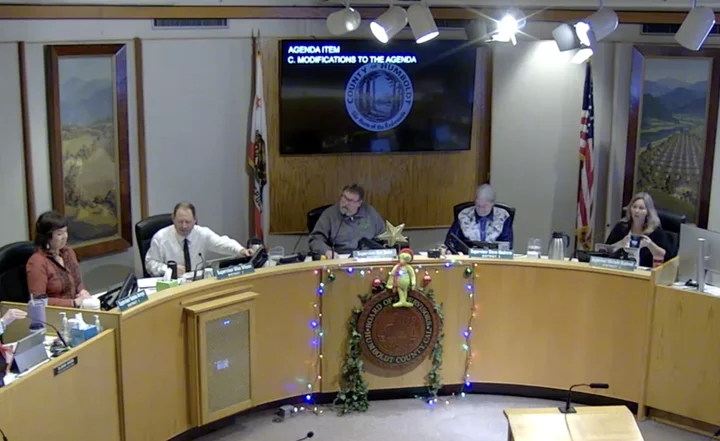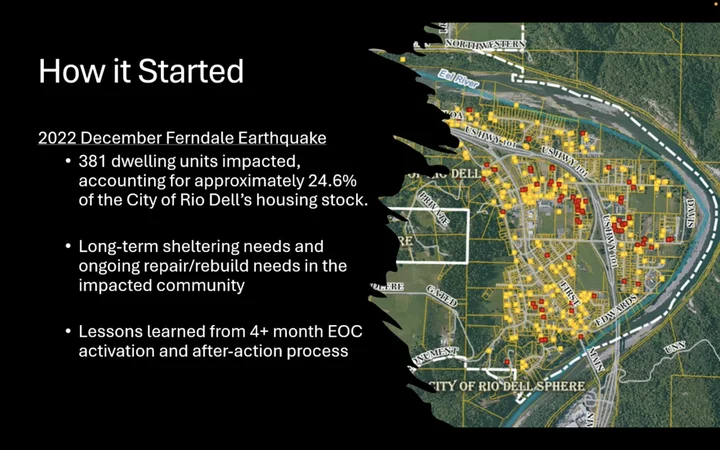The Humboldt County Board of Supervisors (from left): Fourth District Supervisor Natalie Arroyo, Third District Supervisor Mike Wilson, First District Supervisor (and board chair) Rex Bohn, Fifth District Supervisor Steve Madrone and Second District Supervisor Michelle Bushnell. | Screenshot.
###
With the dais adorned in festive Christmas decorations, the Humboldt County Board of Supervisors made fairly quick work of a light agenda on Tuesday. The only big-ticket item under discussion was the presentation of a draft disaster response plan.
In government jargon this type of plan is often called a “Recovery Annex,” though the concept is simple enough: a single document that lays out a roadmap for responding to and recovering from emergencies such as earthquakes, wildfires, flooding, etc. The “Recovery Annex,” in this case, is attached to the county’s Emergency Operations Plan.
Sheriff William Honsal and Office of Emergency Services (OES) Program Manager Ryan Derby delivered the presentation, outlining the major points in the 187-page document, which is nearing the end of its 30-day public review period. (We have until next Monday to submit feedback.)
“And let me just explain this one quick thing,” Honsal said at the outset. “It’s like, if we don’t get this right, the county could lose millions of dollars, okay?”
Derby explained that the inspiration for this plan came in the aftermath of the 6.4 magnitude earthquake and 5.4 magnitude aftershock that struck nearly two years ago, causing two deaths and damaging hundreds of homes and apartments, with Rio Dell receiving the brunt of the devastation.
Screenshot from the presentation.
###
Derby said the goals of this recovery plan include outlining the various stages of recovery, identifying possible state and federal programs that can help in that recovery, and addressing local programs and infrastructure that may need attention to be ready in case of emergency.
While the plan’s length may seem intimidating, Derby said, “It’s really intended to be a sort of choose-your-own-adventure document, where you can use the table of contents as a checklist, depending on where you’re at in the recovery process, rather than having to understand and read the entire document.”
Following federal guidelines, the county’s plan identifies three overlapping recovery phases — short term (days), intermediate (weeks-months) and long-term (months-years).
The plan also incorporates the concept of “community lifelines,” which Derby described as “eight buckets, essentially, that make up the most fundamental services in the community that enable all other aspects of society to function.” Those buckets are identified as:
- Safety and security
- Food, hydration and shelter
- Health and medical
- Energy (power and fuel)
- Communications
- Transportation
- Hazardous materials
- Water systems
“[W]e see lifelines as a way to help prioritize both initial response efforts [and] also long-term, short- and intermediate-term recovery,” Derby said. The OES will use a color-coded system to indicate the status of each lifeline — red for critically damaged, yellow for moderate damage and green for situation normal.
Derby also outlined the critical importance of data management — collecting and organizing information from various community partners to create “a searchable and centralized data set” that can be used for case management and long-term recovery responses.
This has proven challenging in Humboldt County, particularly following the 2022 quake.
After the presentation, Fifth District Supervisor Steve Madrone said the county dodged a bullet with last week’s 7.0 earthquake, a “roller” that didn’t cause nearly as much damage as the 2022 quake and its New Year’s Day aftershock. He also voiced appreciation for the inclusion of water systems in the plan, noting the importance of emergency water storage for local residents, especially those in rural areas.
Fourth District Supervisor Natalie Arroyo asked whether the plan should include more specifics on emergency feeding programs, noting that the North Coast Growers Association is developing one with the nonprofit Humboldt COAD (Community Organizations Active in Disasters).
Derby said the county is engaged in conversations with those organizations.
Wilson asked about the use of discretionary funds, such as the $1 million in county funds set aside for housing assistance for Rio Dell residents in 2023. The county is in leaner times, financially, and Wilson said there should be plans to leverage relief from outside sources.
Honsal said the Recovery Annex lays out the financial thresholds in damages required to trigger FEMA relief, saying it’s unlikely that an earthquake here would ever reach that level.
Wilson also said he often questions why the Office of Emergency Services falls under the authority of the Sheriff’s Office, as opposed to being a standalone division, considering what’s involved in long-term recovery efforts. Law enforcement is valuable in holding civil society together in the immediate aftermath of disaster, he said, “[But] is it really the right institution to maintain those services into the future?”
Quick aside here: Derby noted that the county activated an online form where local businesses and residents can submit damage reports from last week’s earthquake.
“And the goal with that is to see if we can reach the thresholds for federal SBA [Small Business Administration] disaster relief, which is … 25 homes, 25 businesses or a combination of the two,” Derby said. As of this morning, the county had received 13 such reports, mostly concerning minor damage, like TVs falling off the wall. Regardless, if you incurred damage from the quake, especially foundation or structural damage, then click here to access the form.
And if you’d like to review the draft Recovery Annex, you can access a pdf copy at this link.
Boards, Commissions and Committees
An oft-forgotten aspect of serving on the Board of Supervisors is the mandatory (or at least expected) assignments to serve on a wide variety of boards, commissions and committees. Each year the board divvies up the appointments, and today was the day.
Mostly, the board members stuck with the roles they’ve already been serving, with the occasional request to swap in or out based on interest or availability.
There was a brief discussion, though, when it came time to reassign a supervisor to the board of the Humboldt Convention and Visitors Bureau, a nonprofit that has long served as the county’s designated marketing organization. That relationship is set to expire at the end of this year due to a 4-1 decision this past June to stop directing hotel bed tax revenues (aka transient occupancy taxes, or TOT) to the organization.
“Is this necessary to continue forward with this one?” asked Second District Supervisor Michelle Bushnell, who has been filling that role. She said that, since the June decision, the county has not been invited to or notified about the organization’s meetings.
County staff agreed to let this assignment fall by the wayside, though it won’t be official until the appointments are codified at next week’s meeting.
New Parking Restrictions
Early in the meeting, Public Works Director Tom Mattson introduced ordinances that will restrict parking on a few remote roads that have become magnets for nuisances such as garbage dumping and RV burning.
Mattson started with Drydens Road in Orick (near the fairgrounds) and a small stretch of Jackson Ranch Road (in the Arcata Bottoms), noting that the illegal dumping is causing a drain on county resources. He recommended approving an ordinance to restrict parking from 10 p.m. to 5 a.m. on Drydens road and from midnight to 5 a.m. on Jackson Ranch Road, with signage to reflect the new rules. The board quickly and unanimously approved the ordinance.
Next, Mattson introduced a similar ordinance restricting parking on Railroad Avenue in the Fields Landing area. Mattson said a “major issue” has developed around the boat ramp, with the Sheriff’s Office regularly responding to late-night nuisances.
Mattson recommended approving an ordinance to prohibit overnight parking at the location, and with no pubic comment the board unanimously approved it.


CLICK TO MANAGE